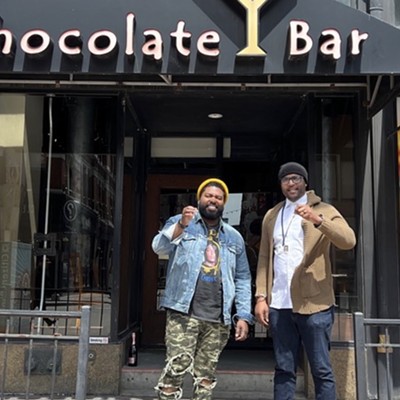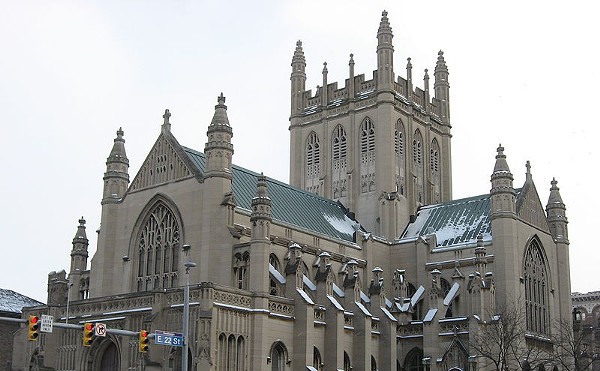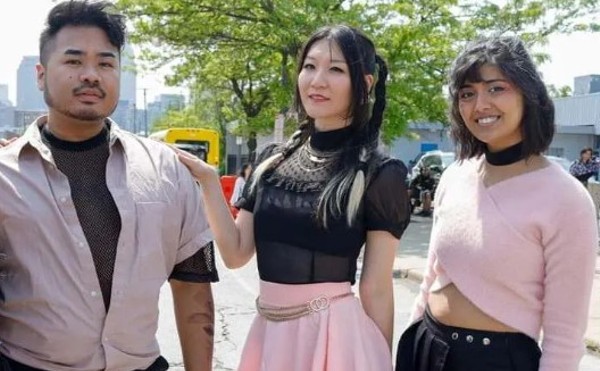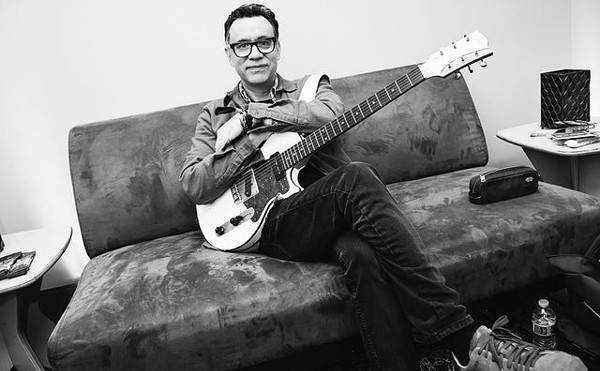NEW
Light to Spare — Art and light go way back — think Dutch masters, the Impressionists, etc. That's what makes this little show so fascinating: Four contemporary artists prove that natural light still matters in this electric age. Philadelphian Morgan Craig speaks Cleveland's language in several large, photo-realistic, oil-on-linen paintings in which light transforms abandoned industrial spaces into touching testaments to impermanence. Finest is "Every Man Builds His Own Castle of Sand," in which sunlight bathes in radiance a dilapidated, rusted-out shell of a shopping arcade. As Craig paints it, the structure is more than a jolting symbol of fragility. It's a once-glorious place enjoying a last hurrah. Something similar happens in Brooklyn artist Lea Bertucci's ingenious installation "Aberrations." A Plexiglas container hanging from the ceiling shows 3-D video footage of an apartment-building wall with windows and fire escapes. Visually, it's a dull subject, but Bertucci's treatment brings it to life. A show about light wouldn't be complete without someone simply pointing skyward, and few could have done so more poetically than Phillip Andrew Lewis, of Youngstown. His "On a Clear Blue Day, You Can See the Sky" consists merely of seven lights in the floor casting a blue patch on the ceiling. Craning to look up, your natural reaction is to wonder when you last paid attention to the real thing. – Through January 4 at SPACES Gallery, 2220 Superior Viaduct, Cleveland, 216-621-2314. — Zachary Lewis
ONGOING
Victoria Anders — Sometimes the right frame really does make all the difference. On their own, these black-and-white, untitled photos of Cleveland might not garner much attention. But as Anders presents them, printed on metal and dangling inside customized aluminum borders, they're sure to turn heads. Subject-wise, Anders is absorbed with Cleveland's aging infrastructure: bridges, railways, and roads, and their brick, stone, and steel components. Printing the prints on metal reminds viewers, perhaps painfully, of Cleveland's status as a fallen Rust Belt stronghold, but what elevates these generally static cityscapes are their frames: thin metal rims delicately cut in ways that accentuate or extend features in the images. The technique has its limitations — her experiments with a human subject are distinct flops — but when it works, it really works. On one strong example, the frame extrapolates a train track viewed head-on; the rails seem to jut from the wall. In another, a bridge's undergirding keeps arcing gracefully beyond the printed surface. In the end, what Anders provides, besides a rather somber tribute to Cleveland, are lessons in art appreciation and creative pointers to a deeper understanding of photography. Through November 30 at The Wooltex Gallery, 1900 Superior Avenue, www.thewooltexgallery.com. — Lewis
Meditations — A year has passed since the grievous murder of Cleveland artist Masumi Hayashi. Time to start measuring the loss. This thoughtful survey is one of three on display in Northeast Ohio, and just like the artist herself, it forges many distinct characteristics into a single experience. The show spans some three decades, capturing a photographer who was true to the aesthetics of Cubism, collage, and mosaic. Oldest here are color-print collages, early examples of Hayashi's deep interest in patterns. For a time, she also explored 3-D photography, relishing its disorienting effects. But her greatest works are "mappings" — large, panoramic images composed of overlapping photos shot at slightly different heights, angles, and times. Hayashi transformed average places into complex, kaleidoscopic landscapes. In one, an image of the West 25th Street Rapid station, a hub for the working poor becomes a crystalline palace flecked with red. Shooting a temple in India, she juxtaposes a statue of a god with an exotic-looking peasant, presenting both as divine entities inside a magical, resplendent place. But most poignant are her personally meaningful subjects. One is Hayashi's 2004 composite portrait of Ed Ezaki, an elderly former resident of a Japanese internment camp, who Hayashi renders as a friendly man full of memories. Ezaki survived the horrors of war and racial segregation. Sadly, he also may have survived Hayashi. Through December 15 at Cleveland State University Art Gallery, 2307 Chester Avenue, 216-687-2103. — Lewis
Erik Neff — Neff, a local painter and draftsman, was recently included in a major museum exhibition in Cleveland. That made sense: It was a group show, and Neff's loosely geometrical abstractions, thickly painted on small canvases, fit into and benefited from the larger theme. But Neff alone is much harder to take. Here, the paintings seem entirely random, visually mute, driven by no particular concept or intention. One standout is "Nodule," in which a blue rectangle frames a light rising in the sky over a smudged, barren landscape. Some viewers detect environmental meaning in Neff's work. Perhaps there's something here about our sacrifice of the external world in pursuit of indoor lives. Who knows? Neff's drawings, meanwhile — small, incoherent improvisations in charcoal, ink, and pastel — are as dull as the paintings, but also flat and lifeless. No doubt Neff had something in mind with them, but there's no guessing what. In one of the more distinctive images, a dark eye seems to stare out mysteriously behind faint, jagged lines, like an ancient hieroglyph on a cracked cave wall. But that would be an act of communication, and there's none of that going on here. Through November 30 at Raw & Co. Gallery, 1009 Kenilworth Avenue, Cleveland, 216-235-0635. — Lewis











